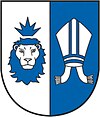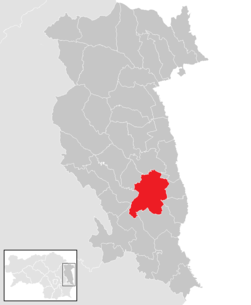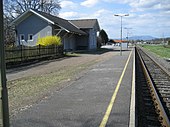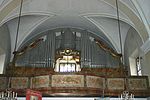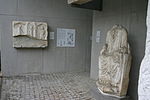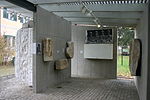Bad Waltersdorf
|
market community Bad Waltersdorf
|
||
|---|---|---|
| coat of arms | Austria map | |
|
|
||
| Basic data | ||
| Country: | Austria | |
| State : | Styria | |
| Political District : | Hartberg-Fürstenfeld | |
| License plate : | HF (from 1.7.2013; old: HB) | |
| Surface: | 52.26 km² | |
| Coordinates : | 47 ° 10 ' N , 16 ° 1' E | |
| Height : | 291 m above sea level A. | |
| Residents : | 3,834 (Jan 1, 2020) | |
| Postcodes : | 8271, 8264 | |
| Area code : | 03333 | |
| Community code : | 6 22 64 | |
| NUTS region | AT224 | |
| Address of the municipal administration: |
Bad Waltersdorf 2 8271 Bad Waltersdorf |
|
| Website: | ||
| politics | ||
| Mayor : | Josef Hauptmann ( ÖVP ) | |
|
Municipal Council : (2020) (21 members) |
||
| Location of Bad Waltersdorf in the Hartberg-Fürstenfeld district | ||
 Town hall with flowers |
||
| Source: Municipal data from Statistics Austria | ||
The health resort Bad Waltersdorf is a market town with 3834 inhabitants (as of January 1, 2020) in the judicial district of Fürstenfeld and in the political district of Hartberg-Fürstenfeld in Styria .
As part of the Styrian community structural reform in Styria, it has been merged with the community of Sebersdorf since 2015 ; the new community continues the name of Marktgemeinde Bad Waltersdorf. The basis for this is the Styrian Municipal Structural Reform Act - StGsrG. Furthermore, on the same date the new municipality was expanded to include the cadastral municipality of Oberlimbach from the neighboring municipality of Limbach bei Neudau .
geography
Geographical location
Bad Waltersdorf is halfway between the district capital Hartberg and Fürstenfeld , in the middle of the Eastern Styrian hill country in the Safental, not far from the border with Burgenland .
Community structure
The municipality includes the following ten localities (residents as of January 1, 2020):
- Bad Waltersdorf (1065) with Buchgraben and Waltersdorfberg
- Geier (223) with Harras, Schmiedböck, Vogelsang and Voitmann
- Hohenbrugg (179)
- Leitersdorf near Hartberg (556) with Buchgreith, Leitersdorfberg and Sauberg
- Lichtenwald (58)
- Neustift near Sebersdorf (174)
- Oberlimbach (96)
- Rohrbach near Waltersdorf (282) with Haller and Wagenhals
- Sebersdorf (741) with Edelsberg, Großhaide, Sebersdorfberg, Steinfeld and Untermayerhofen
- Wagerberg (460) with Hinterfeld, Sonntagsberg and Wagerberg
The community consists of the eight cadastral communities Hohenbrugg, Leitersdorf, Neustift, Oberlimbach, Rohrbach bei Waltersdorf, Sebersdorf , Wagerberg and Waltersdorf and covers 52.26 km².
Neighboring communities
| Ebersdorf | Book-St. Magdalena | |
| Hartl |

|
Neudau |
| Großwilfersdorf | Bad Blumau | Burgau |
All neighboring communities are in the Hartberg-Fürstenfeld district.
history
The local area was already settled in Roman times; some of the numerous finds from this period are exhibited in the small Roman museum near the parish church. This settlement disappeared in the course of the great migration . From the 6th century, the Slovenes settled in the Eastern Alps ( Carantania ); around Bad Waltersdorf they only left traces in the field names (for example, “Safen” means “Froschbach”).
After the area had been deserted for a long time and repeatedly came under different rule, the colonization of Eastern Styria did not begin again until around 1125. The area of today's Bad Waltersdorf was in the possession of the high free or noble Walter von der Traisen, a descendant of Aribo II , who founded the village here and immortalized himself in his name. Waltersdorf was mentioned in a document for the first time in 1170.
In the course of the following centuries there were often invasions by the Hungarians and the Turks , but also by the Haidukes and Kuruzen , whereby a large part of the place was repeatedly destroyed, the last time in 1704.
Waltersdorf has always been the largest town between the cities of Hartberg and Fürstenfeld , was the seat of an original parish and later a deanery . The structure of Waltersdorf was purely agricultural from its foundation until the 19th century, but then slowly began to change. Industry and trade developed (e.g. through up to four markets per year), which increased the economic importance. This development established the survey of the market community in 1928.
The solidarity of the residents with the church was so strong even during the time of National Socialism that in 1939 there was a demonstration of around 200 people against the anti-church measures of the Gauleiter. Towards the end of the Second World War, inner-German refugees from Germany and Yugoslavia were quartered in Waltersdorf. When the retreating German army camped in Waltersdorf, there was a Russian air raid, which caused considerable damage. Coincidentally, the capitulation on May 8, 1945 coincided with the time when the advancing Russian troops reached Waltersdorf. On August 1, the British replaced the Russian occupation .
In the state elections in November 1945, a total of 97 residents in today's municipal area were not eligible to vote because of membership in the NSDAP .
In the post-war period, the road network was expanded, which at that time was barely asphalted; In 1959 the elementary school moved from the parish hall to its present location.
On January 1, 1968, the local parishes of Wagerberg, Leitersdorf and Hohenbrugg were combined with Waltersdorf to form one large parish . In the following years the secondary school, the kindergarten, the outdoor pool and other sports facilities were opened.
In 1975 the crude oil exploration company began drilling , which did not find oil, but thermal water at a depth of 1,150 m. Initially, the thermal spring was used to supply heat: In 1981, the first geothermal district heating supply system in Austria was opened, which was mainly used to heat the schools, the outdoor swimming pool and a test glass house. With the opening of the thermal baths in 1984, tourism began to grow rapidly; a trend that continues to the present day. In 1987 the spa park was designed with a pond and playground.
By a decision of the Styrian state government of October 11, 1988, the market town of Waltersdorf in Eastern Styria was renamed the market town of Bad Waltersdorf , which officially became a health resort . In the same year, the site was also redesigned, in which the old whip lights were replaced by new lanterns and the asphalt surface in the center of the village was replaced by natural stone slabs.
Population development

politics
mayor
At the constituent meeting of the municipal council in April, Josef Hauptmann (ÖVP), who had already headed the municipality until December 31, 2014 and was then appointed government commissioner due to the municipal merger, was re-elected mayor .
The community board also includes the first vice mayor Alois Rath (ÖVP), the second vice mayor Ewald Schalk (FPÖ), the community treasurer Johann Fiedler (ÖVP) and board member Mario Genser (SPÖ).
Municipal council
The municipal council was expanded from 15 to 21 mandataries in 2015 by amalgamating the municipalities. According to the result of the 2015 municipal council elections , it consists of mandataries from the following parties:
The last municipal council elections brought the following results (the results of Oberlimberg in the municipal council elections 2000, 2005 and 2010 are not included in this table):
| Political party | 2015 | 2010 | 2005 | 2000 | |||||||||||||||||
|---|---|---|---|---|---|---|---|---|---|---|---|---|---|---|---|---|---|---|---|---|---|
| Large community | Bad Waltersd. | Sebersdorf | Bad Waltersd. | Sebersdorf | Bad Waltersd. | Sebersdorf | |||||||||||||||
| be right | % | Mandates | St. | % | M. | St. | % | M. | St. | % | M. | St. | % | M. | St. | % | M. | St. | % | M. | |
| ÖVP | 1571 | 65 | 14th | 1075 | 76 | 12 | 566 | 60 | 10 | 1016 | 75 | 12 | 698 | 76 | 12 | 911 | 70 | 11 | 569 | 67 | 11 |
| SPÖ | 407 | 17th | 3 | 262 | 19th | 3 | 273 | 29 | 4th | 193 | 14th | 2 | 218 | 24 | 3 | 165 | 13 | 2 | 193 | 23 | 3 |
| FPÖ | 427 | 18th | 4th | not running | not running | 146 | 11 | 1 | not running | 226 | 17th | 2 | 79 | 9 | 1 | ||||||
| BZÖ | not running | 76 | 5 | 0 | not running | not running | not running | not running | not running | ||||||||||||
| Economic list Haindl | not running | not running | 111 | 12 | 1 | not running | not running | not running | not running | ||||||||||||
| Eligible voters | 3,102 | 1,782 | 1,197 | 1,656 | 1.108 | 1,498 | 1,037 | ||||||||||||||
| voter turnout | 79% | 81% | 81% | 83% | 85% | 88% | 83% | ||||||||||||||
coat of arms
Since July 1, 1967, the community was allowed to use a coat of arms. Due to the amalgamation of the municipalities, the coat of arms lost its official validity on January 1st, 2015. The re-award took place with effect from January 25, 2016.
The blazon (description of the coat of arms) reads:
- "In a shield split by silver and blue, in front a silver lion's head, surrounded by a blue mane, with a blue heather crown floating over it, in front a silver bishop's cap."
The lion's head in the front shield area indicates the important finds from Roman times, which were beautifully displayed in the center of the march in 1966. Due to the blue color, the lion's head, which can be seen on several sculptures in Waltersdorf, is impressed with a temporal remoteness, with the pagan crown symbolizing pre-Christian antiquity. The Bischofsmütze marks the ecclesiastical status of Bad Waltersdorf as an original parish.
Economy and Infrastructure
The economy of Bad Waltersdorf is strongly influenced by tourism and agriculture.
tourism

Bad Waltersdorf is one of the most popular tourist communities in Styria. The place is located in the middle of the two tourist regions of Eastern Styria and Thermen- und Vulkanland Styria . Before the opening of the thermal baths, tourism was mainly limited to summer holidays with low numbers of guests, but afterwards the tourist offer and with it the number of visitors grew strongly.
The Heiltherme Bad Waltersdorf, founded in 1984 and expanded again and again, focuses on the wellness area. With a decision of April 29, 1982 by the Styrian Provincial Government, it was recognized as a curative resource for the supportive treatment of degenerative changes, especially in the context of rheumatic forms (inflammatory, degenerative and soft tissue rheumatism) according to the Styrian Curative Occurrence and Health Resort Act.
In Bad Waltersdorf there are hotels of all categories, with a focus on the four-star range.
Football training camp
Since around 2000, Bad Waltersdorf has repeatedly distinguished itself as a training location for internationally renowned teams as part of the International Football Camp Styria thanks to the well-equipped hotels . Most recently in 2014, the national teams of Iran completed part of the preparation for the 2014 World Cup in Bad Waltersdorf. The national teams of Angola and Montenegro were also guests in 2014. In addition, renowned club teams such as Arsenal FC , AS Roma , Maccabi Tel Aviv , AFC Bournemouth and FC Burnley completed training camps in Bad Waltersdorf in 2014.
traffic
The south autobahn A2 runs through the municipality and can be reached in about two kilometers in the neighboring municipality of Sebersdorf via the Sebersdorf / Bad Waltersdorf junction (126). Stegersbacher Straße B 57a, which runs through neighboring Burgenland, is about eight kilometers away.
There is a stop for the Thermenbahn in the village, which provides a train connection to Vienna via the Wechselbahn and the Aspangbahn . Regional trains to Hartberg and Fehring run every two hours .
The Graz Airport is 60 km away.
Public facilities
An office of the Red Cross and home nursing are housed in the social center.
education
There are the following schools in Bad Waltersdorf:
- an elementary school, which was owned by the Church until 1870. The former parish school is one of the oldest in the district with its first documentary mention in 1586.
- since 1959 a secondary school with an attached polytechnic course, from the 2013/14 school year: new middle school
- a secondary school since 1990
- since 1983 a public music school
Sports
The sports facilities in Bad Waltersdorf include:
- the public outdoor pool with four pools and a large water slide
- the Bad Waltersdorf leisure park , a tennis center with six outdoor courts, including a center court according to the tournament requirements, and four indoor courts
- two public beach volleyball courts
- Thermenstadion Bad Waltersdorf (three soccer fields, one of which is suitable for tournaments and with a grandstand)
- a golf course. The 18-hole course was opened on September 30, 2005 and is designed as a par 72 (yellow CR 69.7; slope 115; red CR 69.5; slope 114).
Every year a hobby beach volleyball tournament takes place, which is one of the largest in Styria. A fun run is also organized annually , the Radio Steiermark-Lauf (formerly Apfelsterzlauf ).
In 1999 the World Hot Air Balloon Championship took place in Bad Waltersdorf.
The ITF Bad Waltersdorf (Thermenregion Bad Waltersdorf Open) has been held annually since 2011 .
Culture and sights
- The Schwarzer Laubfrosch residential building , which was awarded the Geramb Rose architecture prize and caused an international sensation.
- The Walther Fountain, built in 1989, is named after the town's founder and namesake, Walter von der Traisen.
- Exhibitions, concerts, musicals and operettas are regularly held in the Kulturhaus. The community library, music school and café are also located here.
- The spa gardens
- The parish church is dedicated to Saint Margaret of Antioch . Its history goes back to the foundation of the town around 1130; the last time it was built from scratch in 1689–1690.
- Roman Museum
- Obermayerhofen Castle
- Lichtenwalder Moor
- Interior of the parish church
- Roman Museum
Museums
- Next to the parish church is the small Roman museum with the Roman stone collection, which was awarded the Geramb Rose architecture prize.
Regular events
- Wine festival
- ORF Radio Steiermark Lauf
- Parish festival
- Thanksgiving
- Summer night ball
- Sports ball
Site design
Bad Waltersdorf was the winner of the Styrian State Flower Decoration Competition in 2002 and 2007 and came second and third several times. In 2003 it received the award “Most beautiful village in Europe” with a gold medal in the category villages at the European competition Entente Florale Europe .
literature
- Fritz Posch and Albert Pichler: Bad Waltersdorf in the past and present , history of the market community and the parish of Waltersdorf by Fritz Posch, supplemented by the history of the community since 1938 by Albert Pichler, market community Bad Waltersdorf (editor), 1989.
- Albert Pichler: Hohenbrugg and Lichtenwald - woodland in the thermal region , chronicle of the Hohenbrugg cadastral community, self-published by the Bad Waltersdorf community.
Web links
- 62264 - Bad Waltersdorf. Community data, Statistics Austria .
- Community website
- Waltersdorf Entry on Bad Waltersdorf in the Austria Forum (in the AEIOU Austria Lexicon )
Individual evidence
- ↑ Municipal council election 2020 - results Bad Waltersdorf. orf.at , accessed on August 22, 2020 .
- ^ Styrian municipal structural reform .
- ↑ Section 3, Paragraph 4, Item 1 of the Act of December 17, 2013 on the reorganization of the municipalities of the State of Styria ( Styrian Municipal Reform Act - StGsrG). Provincial Law Gazette for Styria of April 2, 2014. No. 31, year 2014. ZDB -ID 705127-x . P. 3.
- ↑ Section 5 (1) of the Styrian Municipal Structural Reform Act - StGsrG. P. 4.
- ↑ Statistics Austria: Population on January 1st, 2020 by locality (area status on January 1st, 2020) , ( CSV )
- ↑ a b Bad Waltersdorf community: community board , accessed on March 19, 2018
- ↑ 2. Announcement of the Styrian state government of January 14, 2016 on the granting of the right to use a municipal coat of arms to the market town of Bad Waltersdorf (political district Hartberg-Fürstenfeld) , accessed on January 26, 2016
- ^ Market community Bad Waltersdorf: The community coat of arms
- ↑ Communications from the Steiermärkisches Landesarchiv 18, 1968, pp. 138/139
- ↑ International Football Camp Styria: IFCS-Campsommer 2014 (accessed on May 17, 2015)
- ^ Golf Club Bad Waltersdorf
- ^ Bad Waltersdorf
- ↑ Hot Air Ballon World Championship Bad Waltersdorf ( Memento from August 25, 2006 in the Internet Archive )
- ↑ Styrian State Flower Decoration Competition 2007 - Award ceremony ( Memento from June 9, 2008 in the Internet Archive )
